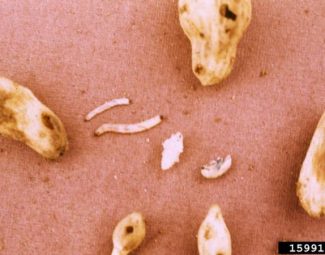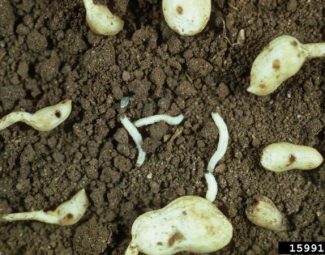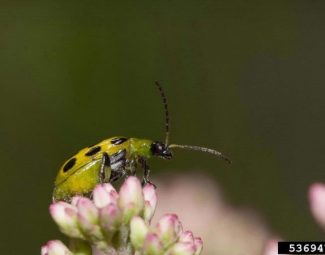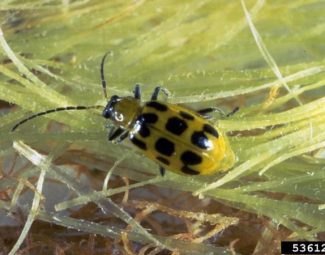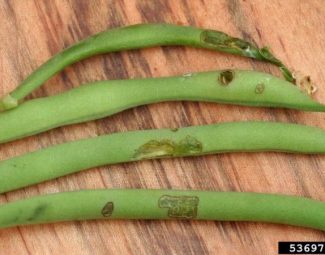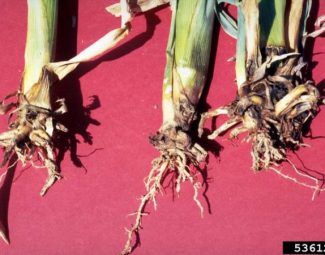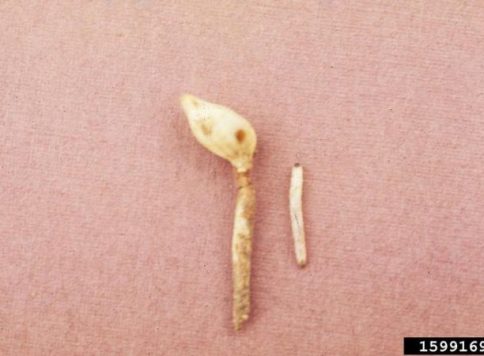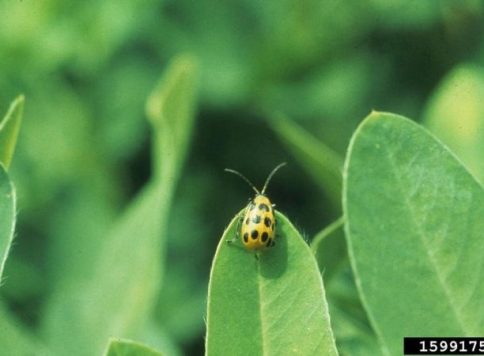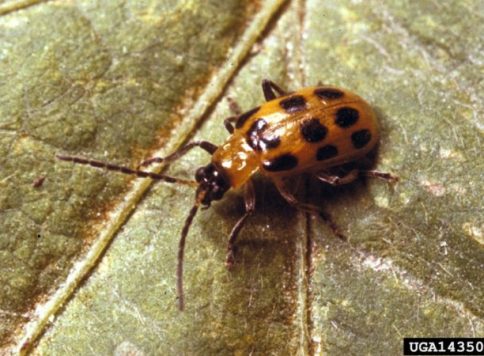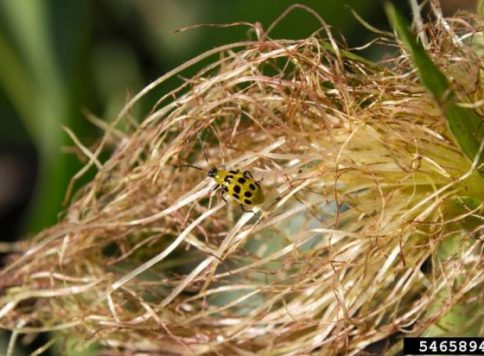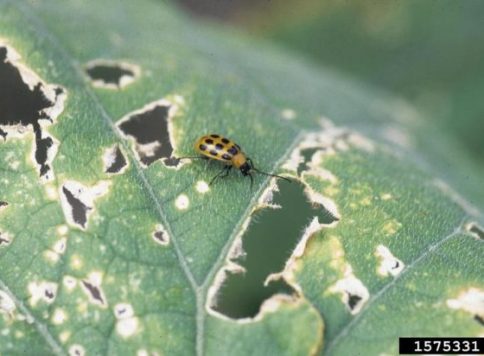Spotted Cucumber Beetle
Insect Summary Report
Diabrotica undecimpunctata howardi
General Information
- Spotted Cucumber Beetle larva are also known as Southern Corn Rootworm.
- Vector for bacterial wilt disease (Erwinia tracheiphila) in most cucurbits and squash and cucumber mosaic virus (and others). Larval feeding on roots increases susceptibility to Fusarium infection.
- Adult will eat holes in leaves and pods of host plants. Larva will feed on roots and tunnel through stems.
- Wide range of host plants that include the roots of beans, peas, potato, corn, peanuts, small grains, tomato, beet, eggplant, cabbage, lettuce and wild grasses. Larvae prefer roots of corn.
Life Cycle 20-39 Days
- Eggs… (5-11 Days) Oval and orange-yellow in color.
- Larva… (10-16 Days) 1/3 to ¾ in. long. Yellowish-white wrinkled body with 6 brown legs.
- Pupa… (5-12 Days) White or yellow. About ¼ in. long. Develops in the soil.
- Adult… About ¼ in. long. Distinguishing 12 black spots against yellow on back. Female can deposit as many as 500 eggs in the soil at base of host plants.
Over-wintering Strategy
- Unmated adults over-winter under the protection of insulating material such as leaf, brush, and trash piles during cold winter temperatures.
- Do not enter diapause, and will become active in winter months during warm temperature conditions.
- Will become continuously active in mid March to May depending on local climate.
Organic Control
- General Info
- Tachinid fly Celatoria diabrotica is natural parasite, but is not commercially available (2010).
- Protective screens.
- Trap Crop – Preferred host such as squash planted before market crop. Trap crop must be monitored and appropriate control measures should be implemented to prevent trap crop from becoming source of infestation.
- Commonly Used Products
- Ferti-Neem Oil
- Ferti-Organics Karanja Oil
- Biorepel (Garlic Oil)
- Neemix 4.5 (Botanical)
- Pyganic 1.4 (Botanical)
- Pyganic 5.0 (Botanical)
- Various Oils: Trilogy, Tritek, Ecotrol Plus, Cedar
- Soaps: Des-X
- Mycotrol ESO (Biological)
- BoteGHA ES (Biological)
Cultural Control
- Cultivate soil thoroughly to disturb any over-wintering adults in soil.
- Plant preferred hosts as late as possible in the spring to force populations into alternate food sources.
- Use of aluminum coated plastic row covers to protect plants, especially during early plant development when seedlings are especially vulnerable. Must be removed prior to bloom.
- Limit or eliminate likely over-wintering sites such as trash and brush piles.
- Eliminate weeds that serve as alternate hosts.
- Remove entire plants that show evidence of bacterial wilt disease.
More Images of the Spotted Cucumber Beetle
Bibliography
- Image by Adam Sisson, Iowa State University, Bugwood.org (adult)
- Images by Clemson University – USDA Cooperative Extension Slide Series, Bugwood.org (larva and adult)
- Image by Jim Jasinski, Ohio State University Extension, Bugwood.org (adult on pumpkin)
- Images by R.L. Croissant, Bugwood.org (adult and damage to corn roots)
- Images by Gerald Holmes, California Polytechnic State University at San Luis Obispo, Bugwood.org (damage on pigweed and Cucumber anthracnose and pest damage)
- Image by Whitney Cranshaw, Colorado State University, Bugwood.org (chewing damage on snap bean pods)
- Image by Susan Ellis, Bugwood.org (adult on flowers)
- Images by John C. French Sr., Retired, Universities:Auburn, GA, Clemson and U of MO, Bugwood.org (adult on peanut plant, larvae/pupae damage, larvae in soil with damaged pods, and peg damage next to larva)
- Image by Daren Mueller, Iowa State University, Bugwood.org (adult)
- http://www.ento.vt.edu/~idlab/vegpests/vegfs/spottedcucumberbeetle.html. (Tachinid Fly).
- http://insects.tamu.edu/fieldguide/bimg182.html (life cycle).
- http://vegetablemdonline.ppath.cornell.edu/factsheets/Cucurbit_Beetles.htm (bacterial wilt and cucumber mosaic vector)
- Caldwell, John S. and Paul Clarke. 1998. Aluminum-coated plastic for repulsion of cucumber beetles. Commercial Horticulture Newsletter, January-February 1998. Virginia Cooperative Extention. Virginia Tech.

